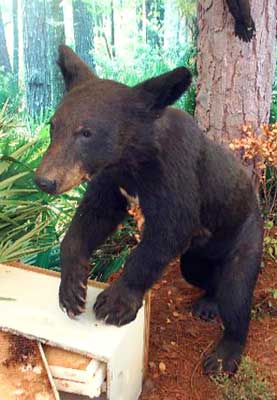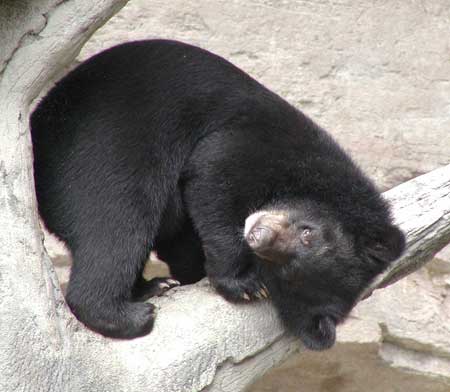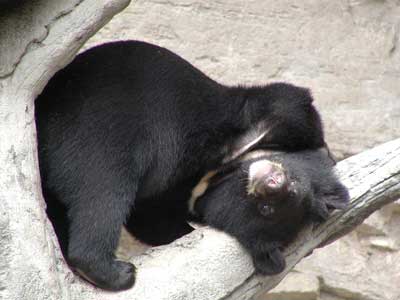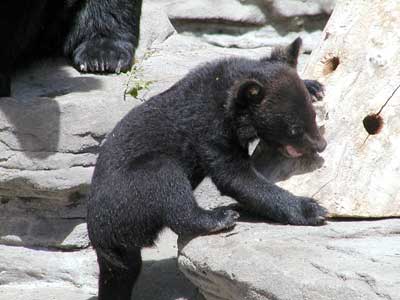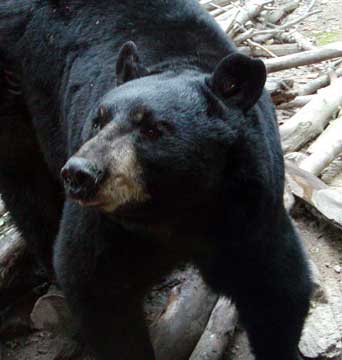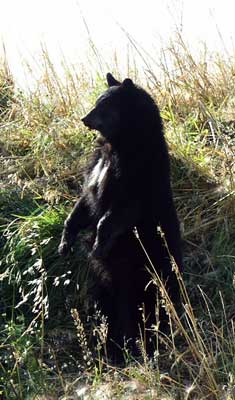|
Family: Ursidae
Black bears (Ursus americanus) used to be found throughout North America (This includes 39 of the 50 U.S. states) from Alaska and Canada to northern Mexico into Sierra Madre Mountains, Nayarit and Tamaulipas states. There are 16 subspecies of black bears based on genetic and morphological differences. The black bear Hibernates and gives birth in winter den. There were probably once as many as two million black bears in North America, there are now more than 600,000 black bears living today.
Anatomy:
The black bear has a heavy body with a short tail, their hind legs are longer than their front so climbing up hill is easier than going down hill. Black bears lack the distinct shoulder hump of the brown/grizzly bear and the claws on the front paws are much shorter and generally not visible from a distance. All of their paws are equipped with strong non-retractable claws which are used for tearing, digging, and climbing. The Black bear grows to about 4 to 6 feet in length and between 256 to 330 pounds in weight. The largest black bear on record, weighing 880 lb. (399 kg.) Cubs usually weigh between 200 and 450 g (between 7 oz and 1 pound) at birth. They have a broad, pointed muzzle, with 42 teeth. Black bears can run as fast as 25 miles per hour while they chase prey, and they are skillful tree climbers. The black bear is plantigrade. They can also stand up in their hind legs for extended periods of time. Black bears like to attack and eat dead creatures, which makes humans feigning death at bear attacks ineffective. Their paws are so strong that a blow of a paw can kill an adult deer. The Kermode bear, often referred to as the ghost bear, has beautiful cream-colored fur. It is found only on three small, isolated islands found off the western coast of British Columbia. The brown eyes and black nose of these bears eliminate any possibility that the Kermode bears are an albino race. Bears can see very well at night, far better than humans
Description and physical appearance:
Black bears fur is dark brown, black or chocolate-brown. Their coloration tends to vary throughout their range (black in eastern regions, yellow-brown in central areas, and gray-blue in the Pacific coastal region). Males are 20 to 60 % larger than the females, sexual dimorphism. They usually have a pale muzzle which contrasts with their darker fur and may sometimes have a white chest spot. Western populations are usually lighter in color, being more often brown, cinnamon, or blonde. Black bears occasionally sport a slight white chest blaze on either side of the Mississippi river Bears see in color, have a keen sense of smell and hear very well.
Diet:
Black bears are omnivores, they eat both plant and animal matter. Black bears are opportunistic feeders not active predators, which means that they can easily adapt to new foraging habitats--from meadows to manzanita bushes, from cars to picnic coolers. Opportunism is often seen as an indication of intelligence in animals and most researchers agree that bears are highly intelligent.
Bears eat almost anything that is easily available such as plant roots, nuts, berries, carrion, fish, crayfish, insects and honey. They spend most of their days foraging for grasses, seeds, berries, acorns, and insects and occasionally feed on carrion. Bears tear open rotten logs or old stumps in search of insect larvae. Meadows also furnish a wide variety of food, such as grass, clover, lily, wild onion, and brodiaea bulbs. The black bear is also a good fisherman. Bears feeding on a protein-rich food source show significant weight gains and enhanced fecundity. Black bears occasionally raid livestock. In Alaska they eat moose calves and salmon. In the Adirondacks park in New York State, they eat a lot of deer calves. However, attacks on livestock are negligible, but the bear does do serious damage to cornfields and honey production.
Black bears like to feed in the cool of the evening or in the early morning.
During the heat of the day, they will often seek shade in the dense underbrush.
Range:
The home ranges of black bears varies by the concentration of food sources. The range of the females is about 1 - 15 square miles (3 - 40 sq km) and the males have a range of about 8-40 square miles (20 - 100 sq km). A male territory is larger and typically overlaps 2 or 3 female territories. Territorial boundaries never overlap with those of the same sex. Territories sizes changes with de availability of food.
Marking territory:
Bears also communicate by marking trees with their scent. This is usually done by standing on two legs and rubbing the back, shoulders, and especially the back of the head on a tree, telephone pole, or other object. They might bite and claw the trees, too. Scent reveals individual identity, reproductive status, and probably mood. Marking is most frequent by adult makes before and during the mating season. Any bear that passes a marked tree is almost certain to stop and smell is and perhaps add its own scent.
Differentiation:
Black bears are distinguished from grizzly or brown bears (Ursus arctos) by their longer, less heavily furred ears, smaller shoulder humps, and a convex, rather than concave, profile
Hibernation:
Contrary to popular belief, bears hibernate lightly, they go into dormancy. Not all bears do this; males typically don't, and bears living in the tropics don't either. It wasn't considered hibernation because the bears' metabolic rate does not drop as much as in animals that do hibernate, and unlike true hibernators, they can awaken at any time during their dormancy. Scientists thought bears weren't true hibernators because their body temperature and respiration rate don't drop drastically as some other hibernators. But modern physiologists believe bears do hibernate; they're just relatively light hibernators compared to other deep hibernating species like ground squirrels or bats.
Life span and threats:
Black bears can live up to 32 years in the wild but most often live for only about 10, primarily because of encounters with humans. More than 90% of black bear deaths after the age of 18 months are the result of gunshots, trapping, motor vehicle accidents, or other interactions with humans. Male bears account for up to 70% of young bear deaths. Now-a-day a major threat to the American black bear is poaching, or illegal killing of more than 40,000 bears per year in the U.S, to supply Asian markets with bear galls and paws, considered to have medicinal value in China, Japan, and Korea.
Illnesses:
Black bears killed in 1989 to 1992 throughout Pennsylvania (USA) were tested for Toxoplasma gondii antibodies Toxoplasma gondii antibodies, which was found in 535 of 665 (80%) bears. The most common parasites are ticks, fleas, mites, lice, tapeworms, roundworms, hookworms and flukes. A disease that seems to affect bears the most is the roundworm: Trichinella.
Social Behavior:
Male and female black bears lead solitary lives, coming together only to mate. During the spring, they are most active at dawn and dusk, in the summer they are most active during the daytime, and in the fall they are active equally throughout the day. They are very aggressive animals, and will fight other bears and animals to protect their territory. The majority of bear fights occur during the mating season, as males will compete with each other over the limited number of receptive females. Female bears are not receptive every year, in fact they may go for 2-3 years without mating to raise their cubs. Thus male bears will readily kill cubs, so that they have a chance to mate with the mother.
Gestation: 220 days
Litter size: 2-3
Age at sexual maturity:
Male: 3-4 years
Female: 3-4 years
Taxonomy, Subspecies and range:
Ursus americanus kermodei (Kermode bear of Gribble Island and British Columbia),
Ursus americanus emmansii (blue bear from British Columbia and the Yukon),
Ursus americanus altifrontalis (southwestern British Columbia)
Ursus americanus carlottae (Queen Charlotte Islands)
Ursus americanus vancouveri (Vancouver island)
Ursus americanus cinnamomun (Cinnamon bear, south-western Canada, and western US)
Ursus americanus hamiltoni (Newfoundland)
Ursus americanus floridanus (Florida)
Ursus americanus luteolus (East Texas)
Ursus americanus luteolus (Eastern Texas, Louisiana, Southern Mississippi)
Ursus americanus machetes (North-central Mexico)
Ursus americanus eremicus (Northeastern Mexico)
Teddy bear and miscellaneous:
The "teddy bear" owes its existence to a young black bear cub chained to a tree near Yazoo City, Mississippi, for Theodore Roosevelt to shoot. He refused to shoot the captive animal.
Winnie the Pooh was inspired by an orphaned black bear cub from the Canadian city of Winnipeg. During World War I, the bear was adopted by a member of the Royal Winnipeg Rifles of the Canadian Infantry and later became the mascot for the company.
On August 2004, the New York Times reported that a wild black bear was found passed out after drinking about 36 cans of beer in Baker Lake, Washington, USA. The bear opened a camper's cooler and used its claws and teeth to puncture the cans. It was found the bear selectively opened cans of Rainier Beer and left all Busch Beer unconsumed.
Smokey Bear, mascot of the United States Forest Service is based on an actual black bear cub found in New Mexico, after a forest fire.
Safety:
Travel in groups, four to six people seems to deter a bear.
Always tell somebody where you are going.
Know what areas are the bears close, avoid traveling through them or be very cautious crossing through them.
Watch for bear signs such as: tracks; droppings which contain vegetation, berries, or hair; claw marks or stripped bark on trees; torn up stumps or rotten logs; and upturned earth.
Under no circumstance approach a fresh kill. Be wary of loosed piles of dirt, vegetation and branches. There may be a carcass and the bear could be protecting near by.
Bring binoculars and use them often to check for bears.
Carry your food in air tight containers that are bear proof.
Make noise when traveling and visibility is low. Sing, talk loudly, you may use horns or bells tied to your backpack. Alert the bears of your presence, but remember the noise may be masked my wind and water.
Bears, like humans, use trails and roads. Don't set up camp close to a trail they might use. Bears are commonly silent.
Avoid cosmetics, scented soaps, perfumes and any article with an strong artificial smell.
If a bear approaches while you are fishing, stop fishing. If you have a fish on your line, don't let it splash. If that's not possible, cut your line. If a bear learns it can obtain fish just by approaching fisherman, it will return for more.
Carry some bear deterrents, 12-gauge shotgun is recommended, Mossberg 12-gauge, Luger .300-Magnum, 2 cans of pepper spray per person, on you all the time.
Cook away from your tent. Store all food away from your campsitein sealed and bear proof container. Hang food out of reach of bears if possible, on a tree branch, far from your tent.
wear a hat while cooking. Do not go to sleep on the same clother you used to cook, because they have the scent.
Do not bring any food to your tent. Not even an strip of gum
Seal all your garbage and deposit it on bear proof garbage disposal
Black bears encounters:
When encountering a bear in the wild (particularly in Canada and the Western U.S.), first identify what type of bear it is as that will determine your defensive measures. Black bears are generally smaller and have no large hump on their back like grizzly bears. For black bears, you are better off trying to scare them off rather than playing dead. To do this, huddle together if in a group, raise your hands or backpack in the air to make yourself appear larger, and make plenty of noise. You will probably scare it away unless you are separating it from cubs.
Do not look it dead in the eye. If it rears up, it does not necessarily mean aggression: a black bear's range of view is three feet off the ground whereas a human's is between five and six. It is trying to pick up your scent and figure out what you are and if you are a threat. It may sniff the air or swing its head from side to side. You can assess its mood by seeing if it makes a popping sound with its jaw. If it does, it is a warning that it is uncomfortable. That is a sign to slowly back away (if possible) and leave.
If threatened, a bear may engage on behavior to scare away an opponent. These may include huffing, panting, hissing or growling; looking directly at you, sometimes with lowered head or ears laid back; slapping one or both feet on the ground; jawpopping; or charging to within several meters, then stopping suddenly or veering to the side. Threat displays may be followed by an attack
A hunting bear does not bother with displays and shows no signs of annoyance or fear. It may approach you directly at a fast walk or turn, follow you, or circle carefully, making cautious approaches
If a Black bear does charge, unlike grizzly bears, you should fight back! Using whatever gear you have close on hand attempt to injure it such that it no longer finds you worth the fight. In particular, aim for the nose as it is a sensitive part of the bear. Its thick skull makes blows to the top and side of the head nearly useless. It is not uncommon for black bears to disengage after being injured' pepper spray in the eyes has been known to work. If fighting the bear does not seem like a wise choice, consider other options. If you play dead, black bears, unlike grizzlies who may leave you alone, will eat you or drag you away.
You cannot outrun a black bear (they are faster than you think). Also, if you climb a tree, you will soon see the bear coming up after you as black bears also climb trees. Never imitate bear sounds or make a high-pitched squeal. The �distance of concern� for a bear is considerably less than 100 yards.
Bears are often attracted to synthetic materials and have been known to eat or chew on inflatable boats, gas cans, sleeping bags, tents, motor oil and seats
Bears as medicine:
Bear gall bladders being used as medicine. Medical applications include treatment of life-threatening cancers, burns, pain and redness of the eyes, asthma, sinusitis and pain in general. Bear gall bladder is also used to treat serious liver ailments and as a tonic to prevent liver damage from over-consumption of alcohol.
Bears are the only mammals to produce significant amounts of the bile acid tauro ursodeoxycholic or UDCA. The Giant Panda is the only exception to this rule in that it produces no UDCA, and anecdotal evidence suggests this is the only bear species not hunted specifically for its gall bladder. Today, UDCA made synthetically from cow bile is used in Western medicine to dissolve gallstones and has shown promise in treating a fatal form of cirrhosis. China, Japan and South Korea together consume nearly 100 tonnes of synthesized UDCA every year -- well over half the world's annual consumption. However, no documentation attests as strongly to the continuing popularity of bear gall bladder in East Asia as does China's bear bile farms, where nearly 10,000 bears are kept and bile is routinely drained from live bears through devices implanted surgically in their gall bladders. |


